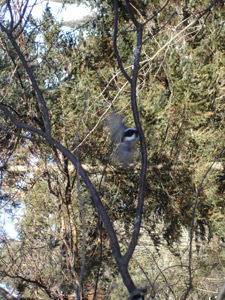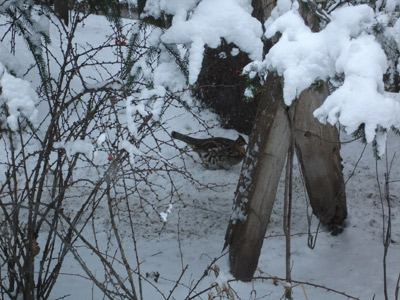FENCEROWS...Snowbirds
By John Luthens
When the killing hand of winter lays its hand on the northern woods, there are those who fly south to warmer climates; snowbirds, I think they are called.
Call me crazy, but I’ll take the cold. I’ll take the logging trails and the snow draped pines, and I’ll take the deer paths that lead into the slashed bottom tangles of popple and ash. Those are the places I prefer. Those are the places where the real snowbirds hide.
With real winter setting in, I found myself in the frozen reaches of Douglas County, to eat the last of my mother’s Christmas cookies and to celebrate another year come and gone. It wasn’t a warm ocean view, but the crackling of a fireplace in the cabin hearth is even better as far as I’m concerned. It beats back the sub-zero chill that routinely visits the farthest of northwestern Wisconsin.
The fireplace was my friend. I needed it, because the early daylight hours found me packing my way into far corners of the Brule River State Forest. It was a snowy fling at late season grouse.
 |
 |
| Black-capped chickadee in flight. | A Winter grouse. |
Hunting up winter grouse can be a tricky proposition. They shelter deep beneath the thickest pines or on the southern tangled slopes where the short-lived winter sun pokes through. Winter birds sit tight. If you find one, you usually find more. The trick is, of course, to actually find the first one.
My late season plan of attack for grouse involves an early morning ritual that could be considered a bit extreme. I lace into heavy-duty sneakers, carefully balance the thermometer and wind chill against the lightest-weight gear I can get away with, and hit the logging roads and snowmobile trails for a morning jog.
The best case scenario is to flush some grouse from under their pine tree roosts along the trails. They won’t fly far in the early morning when temperatures are at their lowest ebb. I don’t blame them. It’s not like those nice sun-drenched autumn days, with the leaves crisp and golden, when it’s actually great fun to flush a bird several times, gauging where he lands and how you can outsmart him, seeing how lost and turned around you can become in the hills and thickets.
Grouse in the northern winter, like any animal, need to conserve every ounce of energy if they hope to survive to see another spring. I really don’t want to chase them far at all. The birds necessarily come out to feed in the window of the day when the temperatures are at a premium and energy conservation can be maximized. I feel a kinship of sympathy with them in the winter. I don’t want to run them down to a point of exhaustion, where another cold night may find them without enough cover or food to make it through.
Often, when I plod along in the early morning, it’s often the case that I don’t flush birds at all. With enough snow cover, the birds will actually burrow themselves down for the night into the drifts and powder, staying insulated against the heat-sucking nights. They dive in deeply enough to hide their presence from night predators.
If it’s cold enough to keep the birds in their snow nests, my morning run become a neck-twisting and eye-peeling search for forked and miniature snow-shoe tracks. I’ve read that grouse in winter grow projections off the side of their toes to help keep them walking above the snow. I don’t know this for sure, and it’s hard for me to tell by looking at the tracks, or by looking at the feet of one of the rare ones that I actually bag in winter. But I’d like to think it is so. The tracks, when you find them, are quite obvious, wandering aimlessly along snow-capped logs and beneath the low boughs of spruce and balsam.
I myself try to keep running as fast as possible with the sole purpose of wearing off the numbing cold. By the end of my jaunt I usually manage to find where a few grouse are hiding for the day. And every winter morning I’m reminded that I should take a lesson from the birds and wear snowshoes instead of trying to stay above the snow crust in my jogging shoes, not to mention keeping the majority of my own toe projections from getting frostbitten.
The sight of the winter morning sun struggling to get above the horizon, peeking through the pines and turning sculpted snowdrifts into dark blue rainbows, almost makes up for the cold and the potential frostbite. I break trails into breathtaking winter scenes where snow falls in powder bombs from high tree perches in the slightest wind and the freezing sap in the trees cracks like the report of a rifle. These things I consider a welcome hazard to the morning run.
There are other birds of winter to occupy my early morning runs too. Blue jays screech at my intrusion into their domain, either in annoyance to my trespass, or in pure blind amazement that some crazy human would be up and running through the snow at such an early hour.
And always it seems that the trees are alive with black-capped chickadees. They flit from branch to branch, happy in any weather. Chickadees have kept my attention on more deer stands than I care to count over the years. They are an ingrained part of any winter setting in Wisconsin. The fact that chickadees can lower their body temperatures at night, going into a self-induced hypothermia, allows them to wake bright and happy in the morning with a minimum of energy spent warding the cold nights.
At least they always seem happy to me. But I’m not a chickadee or, for that matter, a winter grouse who can bury into the snow for warmth. Any hypothermia I incur on my morning scouting runs is idiotically well-deserved.
For me to warm up, I need to return to the base-camp fireside, drink about two quarts of coffee, and of course feed hungrily on Christmas cookies and fudge. Only then can I return to the trails where I’ve seen the most sign and commence the day’s hunting.
By afternoon, I’m usually into second growth birch and aspen slashing, where the grouse feed on any buds and twigs that they can scavenge. I’m dressed for the weather by then with camera binoculars and shotgun in tow.
And the best part is that I never need to make a New Year’s resolution to wear off the extra calories from all my holiday cheer. They are gone faster than the snowbird people who fly off to Arizona and Florida for the cold season; I even have room to eat a grouse or two, dripping with gravy and consumed next to the crackling oak logs of a northern Wisconsin fireplace.









